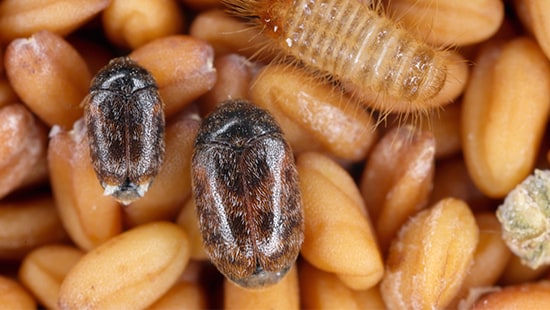Invasive Species Increase Pest Risk in Food Facilities
The Pest Monitor Newsletter

What do certain species of ants, beetles and cockroaches have in common? Hint: it’s in the name.
At one time, the German cockroach, Argentine ant, Khapra beetle – and many other common invasive insects – were not found in the U.S. Rather, native to other parts of the world, these insects were carried into the U.S., most often on goods and human transport, became established, and became invasive pests.
It is interesting to note, however, that an insect’s common name can be deceptive. The German cockroach is so named because it was once believed to be native to Europe, but it is most likely to have originated in Southeast Asia. Even the American cockroach is a misnomer, as it is actually native to Africa and the Middle East.
The German cockroach is an all-too well-known threat to food facilities, which can invade without notice and build up into an infestation in a short time because of its small size, propensity to gather in hidden places, and prodigious rate of reproduction. But there are many lesser-known invasive species that are just as critical to food businesses. Two examples of the significant threat of such invasive pests are that of the khapra beetle and the brown marmorated stink bug.
- Khapra beetle. Ranked as one of the “top 100 worst invasive species of all time” by the Invasive Species Specialist Group, this beetle is thought to have originated in India and the Middle East. It infests stored grains and finished products, eating or making them inedible. First detected in the U.S. in the 1940s, the khapra beetle’s feeding is so damaging – spoiling 30% to 70% of a product, it has been designated a U.S. quarantine pest. Thus, it is mostly eradicated from the country but has still been found in some states and imported grains.
- Brown marmorated stink bug. Among Entomology Today’s list of four “most wanted” invasive insect species, the brown marmorated stink bug (BMSB) was accidentally introduced to the U.S. in the mid-1990s. The stink bug primarily impacts agriculture, affecting many plants, tree nuts and fruits. However, it also is an occasional invader of facilities, as it slips between building siding, joints, or other cracks or gaps as the weather cools, then often exits into the building rather than outdoors as the weather warms. BMSB also is relevant to manufacturers shipping goods to Australia/New Zealand, as goods may need to be fumigated for this invasive insect.
Invasive insect species can quickly proliferate in global regions where they are nonnative, often because of a lack of natural predators. As their numbers expand, their threat increases through agricultural damage, spread of disease (such as malaria and the Zika virus), and even resource competition to native species.
With global trade and travel being primary means of access to new world regions for invasive insect species, the resurgence of both with the waning of COVID-19 is likely to increase the potential of new invasive species being brought into the U.S. While management of these pests can be more complex than management of native species, a pest-free environment can be maintained through a proactive, targeted Integrated Pest Management (IPM) program that is built on scientifically proven protocols.
A Targeted IPM Program For Your Facility
The first step in targeting these pests is the performance of inspection and assessment of the facility to determine both pest presence and risk. Once pests are identified and risks are ascertained, a pest-specific management program can be customized to target those pests and areas.
Included as a part of any program will be a partnership between the facility and the pest elimination service specialist. This is an essential aspect of a successful program for many reasons:
- Because plant workers are in the facility (on the floor, in breakrooms, restrooms, and even exterior lunch/smoking areas), they are the ones who are most likely to see a pest or signs of their presence. Thus, communication to the service specialist – through the logbook, manager notification, etc. – will enable quick action to keep an infestation from building.
- Cleaning and sanitation are critical components of an IPM program, so ensuring these are at their best at all times is one of the most important things a facility can do to help keep the plant pest-free.
- Regular communication between facility management and the service specialist will help to ensure that the program continues to meet your needs and remains responsive to any new areas of concern.
Whether invasive or native, insect pests are a significant threat in food facilities as these structures can provide for the most basic of needs – food, water and shelter – of living creatures. But with proactive, targeted programs, the threats can be controlled, and your foods and business protected.
See Ecolab's Food Protect Program for more information about a targeted IPM program for your facility.


